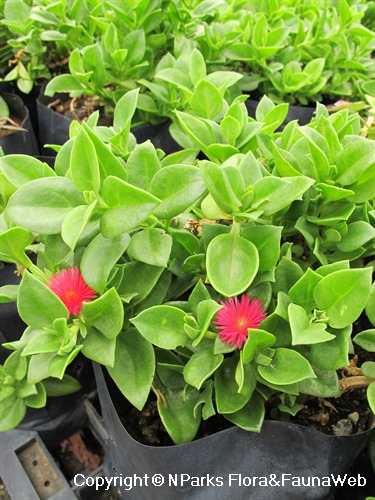
Back
Mesembryanthemum cordifolium L.f.
| Family Name: | Aizoaceae |
| Synonyms: | Aptenia cordifolia (L.f.) Schwantes |
| Common Name: | Baby Sun Rose, Heartleaf Iceplant, Ice Plant, Red Aptenia, Dew Plant, Rock Rose |
Name
Classifications and Characteristics
| Plant Division | Angiosperms (Flowering Seed Plants) (Dicotyledon) |
|---|---|
| Plant Growth Form | Herbaceous Plant |
| Lifespan (in Singapore) | Perennial |
| Mode of Nutrition | Autotrophic |
| Maximum Height | 0.3 m |
Biogeography
| Native Distribution | South Africa |
|---|---|
| Native Habitat | Terrestrial (Desert / Semi-Desert) |
| Preferred Climate Zone | Desert / Arid |
Description and Ethnobotany
| Growth Form | Creeping succulent perennial. |
|---|---|
| Foliage | Light green, smooth, fleshy leaves are ovate or heart-shaped with entire leaf margin (6 cm long, 2.5 cm wide). Opposite, stalkless leaves are slightly folded inwards. |
| Stems | Stem may be 4-angled or round (60 cm long). It grows prostrate along the ground. |
| Flowers | Bright red or orange flowers occur singly or in clusters of 3 at the stem tips (1.5 cm wide). The flowers resemble asters, having many thin, linear petals and a small yellow center. Flowers open around noon or early afternoon. |
| Fruit | Dry, dehiscent fruits are known as capsules. Capsules are 4-chambered with each chamber containing one brown to black, rough-textured seed. |
| Associated Flora | This species is endemic to South Africa. It is found along the coast or in areas that receive summer rainfall. It occurs at altitudes of 20 - 800 m. |
| Cultivation | In Singapore, this species requires air conditioning to survive. For optimal growth, plant this species in fertile, well-draining sandy soil enriched with compost, leaving 0.5 - 0.6 m of space between individuals. Feed plants with a slow release fertilizer. For container plantings, use pots at least 20 cm deep and allow the soil to dry before rewatering. Propagate by seed, stem cuttings or division. Stem cuttings root easily in about 3 weeks. |
| Etymology | The genus "Aptenia" is derived from the Latin word that means wingless ("apten"). The reference is to the seeds which lack wings. The species epithet "cordifolia" originates from the Latin words for heart ("cor") and leaf ("folium"). It refers to the heart-shaped leaves. |
| Ethnobotanical Uses | Others: Medicine: The leaves are applied as a poultice on wounds. It is also used as a gentle enema for babies. |
Landscaping Features
| Landscaping | It is suitable for container plantings and would be attractive draped over the sides of a hanging basket. |
|---|---|
| Desirable Plant Features | Ornamental Flowers, Ornamental Foliage |
| Landscape Uses | Flowerbed / Border, Suitable for Hanging Baskets, Container Planting, Interiorscape/ Indoor Plant |
| Usage Hazard - Cons | Invasive / Potentially Invasive |
| Plant & Rootzone Preference or Tolerance Remarks | Sandy soil |
Fauna, Pollination and Dispersal
| Pollination Method(s) | Biotic (Fauna) (Insects (Bee)) |
|---|---|
| Seed or Spore Dispersal | Abiotic (Explosive Dehiscence) |
Plant Care and Propagation
| Light Preference | Full Sun |
|---|---|
| Water Preference | Little Water |
| Plant Growth Rate | Fast |
| Rootzone Tolerance | Well-Drained Soils |
| Maintenance Requirements | Low |
| Propagation Method | Seed, Stem Cutting, Division |
Foliar
| Foliage Retention | Evergreen |
|---|---|
| Mature Foliage Colour(s) | Green |
| Mature Foliage Texture(s) | Smooth, Glossy / Shiny, Thick |
| Foliar Type | Simple / Unifoliate |
| Foliar Arrangement Along Stem | Opposite |
| Foliar Shape(s) | Non-Palm Foliage (Ovate, Cordate) |
| Foliar Venation | Pinnate / Net |
| Foliar Margin | Entire |
| Foliar Apex - Tip | Acute |
| Foliar Base | Rounded / Obtuse |
| Typical Foliar Area | Microphyll ( 2.25cm2 - 20.25 cm2 ) |
| Leaf Area Index (LAI) for Green Plot Ratio | 4.5 (Shrub & Groundcover - Dicot) |
Non - Foliar and Storage
| Stem Type & Modification | Herbaceous |
|---|---|
| Root Type | Underground (Tap Root) |
| Specialised Storage Organ(s) | Aboveground |
Floral (Angiosperm)
| Flower & Plant Sexuality | Bisexual Flowers |
| Flower Colour(s) | Orange, Red |
|---|---|
| Flower Symmetry | Radial |
| Individual Flower Shape | Ligulate / Strap-shaped |
| Flower Size - Remarks | 1.5 cm wide |
| Inflorescence Type | Head / Capitulum |
| Flowering Period | Free-Flowering |
| Flowering Opening Time | Daytime |
| Flowering Habit | Polycarpic |
Fruit, Seed and Spore
| Fruit Classification | Simple Fruit |
|---|---|
| Fruit Type | Dehiscent Dry Fruit , Follicle |
Image Repository
Others
| Master ID | 386 |
|---|---|
| Species ID | 1682 |
| Flora Disclaimer | The information in this website has been compiled from reliable sources, such as reference works on medicinal plants. It is not a substitute for medical advice or treatment and NParks does not purport to provide any medical advice. Readers should always consult his/her physician before using or consuming a plant for medicinal purposes. |









